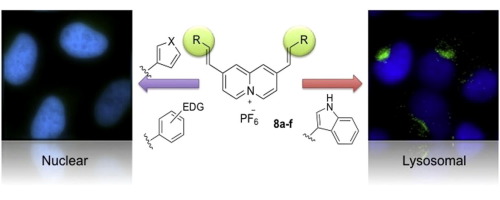https://quibio.web.uah.es/group/
y actualice sus enlaces.
Publicaciones > Zacharioudakis et al
Quinolizinium as a new fluorescent lysosomotropic probe.
1. Institut Curie, PSL Research University, Organic Synthesis and Cell Biology Group, 26 rue d’Ulm, 75248 Paris Cedex 05, France, CNRS UMR3666, 75005 Paris, France, INSERM U1143, 75005 Paris, France. 2. Departamento de Química Orgánica y Química Inorgánica, Universidad de Alcalá, 28871 Alcalá de Henares, Madrid, Spain.
Abstract
We have synthesized a collection of quinolizinium fluorescent dyes for the purpose of cell imaging. Preliminary biological studies in human U2OS osteosarcoma cancer cells have shown that different functional groups appended to the cationic quinolizinium scaffold efficiently modulate photophysical properties but also cellular distribution. While quinolizinium probes are known nuclear staining reagents, we have identified a particular quinolizinium derivative salt that targets the lysosomal compartment. This finding raises the question of predictability of specific organelle targeting from structural features of small molecules.

